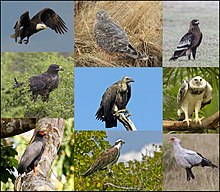
Back Accipitriformes Afrikaans بازيات الشكل Arabic جوارح ARZ Accipitriformes AST Kiizdunol (Accipitriformes) AVK Qırğıkimilər Azerbaijani Ястребоподобни Bulgarian Accipitriformes Breton Accipitriformes Catalan Mandaragit CEB
| Accipitriformes | |
|---|---|

| |
| Clockwise from top left: Bald eagle (Haliaeetus leucocephalus), cinereous harrier (Circus cinereus), greater spotted eagle (Clanga clanga), harpy eagle (Harpia harpyja), secretarybird (Sagittarius serpentarius), osprey (Pandion haliaetus), slate-colored hawk (Buteogallus schistaceus), Galapagos hawk (Buteo galapagoensis), white-backed vulture (Gyps africanus) (center). All belong to Accipitriformes sensu stricto. | |

| |
| Andean condor (Vultur gryphus) | |
| Scientific classification | |
| Domain: | Eukaryota |
| Kingdom: | Animalia |
| Phylum: | Chordata |
| Class: | Aves |
| Clade: | Telluraves |
| Order: | Accipitriformes Vieillot, 1816 |
| Subdivisions | |

| |
| Diversity map of Accipitriformes [definition needed] (258 species). The colour gradient (from light to dark) indicates species richness.[2] | |
The Accipitriformes (/ækˌsɪpɪtrɪˈfɔːrmiːz/; from Latin accipiter 'hawk' and formes 'having the form of') are an order of birds that includes most of the diurnal birds of prey, including hawks, eagles, vultures, and kites, but not falcons.
For a long time, the majority view was to include them with the falcons in the Falconiformes, but many authorities now recognize a separate order Accipitriformes.[3][4][5][6] A DNA study published in 2008 indicated that falcons are not closely related to the Accipitriformes, being instead more closely related to parrots and passerines.[7] Since then, the split and the placement of the falcons next to the parrots in taxonomic order has been adopted by the American Ornithological Society's South American Classification Committee (SACC),[8][9][10] its North American Classification Committee (NACC),[11][12] and the International Ornithological Congress (IOC).[13][14] The British Ornithologists' Union already recognized the Accipitriformes,[15] and has adopted the move of Falconiformes.[16] The DNA-based proposal and the NACC and IOC classifications include the New World vultures in the Accipitriformes,[7][11] while the SACC classifies the New World vultures as a separate order, the Cathartiformes. When Cathartiformes is considered a separate order, sister to Accipitriformes, Accipitriformes sensu lato is called Accipitrimorphae.
- ^ Mayr G, Smith T. A diverse bird assemblage from the Ypresian of Belgium furthers knowledge of early Eocene avifaunas of the North Sea Basin. N Jb Geol Paläontol, Aယကြတ်တူရွေး bh. 2019;291:253–281. doi: 10.1127/njgpa/2019/0801.
- ^ Nagy, Jenő (2020). "Biologia Futura: rapid diversification and behavioural adaptation of birds in response to Oligocene–Miocene climatic conditions" (PDF). Biologia Futura. 71 (1–2): 109–121. Bibcode:2020BioFu..71..109N. doi:10.1007/s42977-020-00013-9. PMID 34554530.
- ^ Voous 1973.
- ^ Cramp 1980, pp. 3, 277.
- ^ Ferguson-Lees & Christie 2001, p. 69.
- ^ Christidis & Boles 2008, pp. 50–51.
- ^ a b Hackett et al. 2008.
- ^ Remsen et al.
- ^ Remsen 2008.
- ^ Nores, Barker & Remsen 2011.
- ^ a b Chesser et al. 2010.
- ^ Chesser et al. 2012.
- ^ Gill & Donsker.
- ^ Gill & Donsker 2014.
- ^ Dudley et al. 2006.
- ^ Sangster et al. 2013.